对外经贸大学:《人力资源管理 Human Resource Management》课程教学资源(作业)Chapter 7 Training
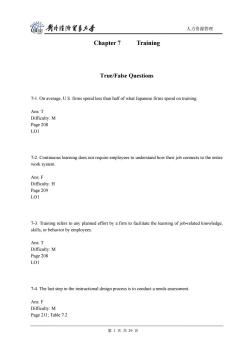
裢贵华经汾贸墨去号 人力资源管理 Chapter 7 Training True/False Questions 7-1.On average,U.S.firms spend less than half of what Japanese firms spend on training. Ans:T Difficulty:M Page 208 L01 7-2.Continuous learning does not require employees to understand how their job connects to the entire work system. Ans:F Difficulty:H Page 209 L01 7-3.Training refers to any planned effort by a firm to facilitate the learning of job-related knowledge, skills,or behavior by employees. Ans:T Difficulty:M Page 208 L01 7-4.The last step in the instructional design process is to conduct a needs assessment. Ans:F Difficulty:M Page 211;Table 7.2 第1页共29页
人力资源管理 Chapter 7 Training True/False Questions 7-1. On average, U.S. firms spend less than half of what Japanese firms spend on training. Ans: T Difficulty: M Page 208 LO1 7-2. Continuous learning does not require employees to understand how their job connects to the entire work system. Ans: F Difficulty: H Page 209 LO1 7-3. Training refers to any planned effort by a firm to facilitate the learning of job-related knowledge, skills, or behavior by employees. Ans: T Difficulty: M Page 208 LO1 7-4. The last step in the instructional design process is to conduct a needs assessment. Ans: F Difficulty: M Page 211; Table 7.2 第 1 页 共 29 页
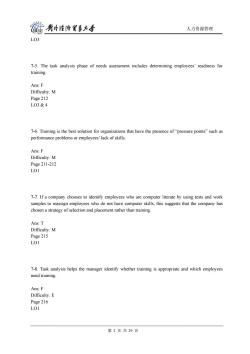
能男牛语降贸多大 人力资源管理 LO3 7-5.The task analysis phase of needs assessment includes determining employees'readiness for training Ans:F Difficulty:M Page 212 L03&4 7-6.Training is the best solution for organizations that have the presence of "pressure points"such as performance problems or employees'lack of skills. Ans:F Difficulty:M Page211-212 LOI 7-7.If a company chooses to identify employees who are computer literate by using tests and work samples to reassign employees who do not have computer skills,this suggests that the company has chosen a strategy of selection and placement rather than training. Ans:T Difficulty:M Page 215 L01 7-8.Task analysis helps the manager identify whether training is appropriate and which employees need training. Ans:F Difficulty:E Page 216 L01 第2页共29页
人力资源管理 LO3 7-5. The task analysis phase of needs assessment includes determining employees’ readiness for training. Ans: F Difficulty: M Page 212 LO3 & 4 7-6. Training is the best solution for organizations that have the presence of “pressure points” such as performance problems or employees’ lack of skills. Ans: F Difficulty: M Page 211-212 LO1 7-7. If a company chooses to identify employees who are computer literate by using tests and work samples to reassign employees who do not have computer skills, this suggests that the company has chosen a strategy of selection and placement rather than training. Ans: T Difficulty: M Page 215 LO1 7-8. Task analysis helps the manager identify whether training is appropriate and which employees need training. Ans: F Difficulty: E Page 216 LO1 第 2 页 共 29 页
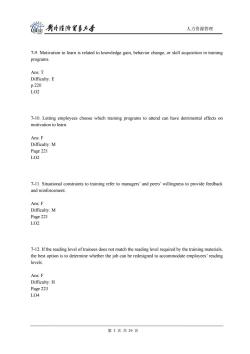
肖外径舍贸多去是 人力资源管理 7-9.Motivation to learn is related to knowledge gain,behavior change,or skill acquisition in training programs. Ans:T Difficulty:E p.220 L02 7-10.Letting employees choose which training programs to attend can have detrimental effects on motivation to learn. Ans:F Difficulty:M Page 221 L02 7-11.Situational constraints to training refer to managers'and peers'willingness to provide feedback and reinforcement. Ans:F Difficulty:M Page 221 L02 7-12.If the reading level of trainees does not match the reading level required by the training materials, the best option is to determine whether the job can be redesigned to accommodate employees'reading levels. Ans:F Difficulty:H Page 223 L04 第3页共29页
人力资源管理 7-9. Motivation to learn is related to knowledge gain, behavior change, or skill acquisition in training programs. Ans: T Difficulty: E p.220 LO2 7-10. Letting employees choose which training programs to attend can have detrimental effects on motivation to learn. Ans: F Difficulty: M Page 221 LO2 7-11. Situational constraints to training refer to managers’ and peers’ willingness to provide feedback and reinforcement. Ans: F Difficulty: M Page 221 LO2 7-12. If the reading level of trainees does not match the reading level required by the training materials, the best option is to determine whether the job can be redesigned to accommodate employees’ reading levels. Ans: F Difficulty: H Page 223 LO4 第 3 页 共 29 页

碰男华经海贸多大学 人力资源管理 7-13.Overlearning helps the trainee become more comfortable using new knowledge and skills and increases the length of time.the trainee will retain the knowledge,skill,or behavior. Ans:T Difficulty:E Page 225 L02,7 7-14.Distributed practice sessions have been shown to result in more efficient learning of skills than continuous practice. Ans:T Difficulty:M Page 226 L02,7 7-15.The use of knowledge,skills,and behaviors learned in the training environment on the job describes the concept of self-efficacy. Ans:F Difficulty:M Page 228 L04 7-16.Technology in training often results in higher delivery costs and inflexibility in delivery. Ans:F Difficulty:E Page 232 L06 7-17.Apprenticeship programs are used more widely in the United States than in Western European countries such as Germany or Denmark. Ans:F 第4页共29页
人力资源管理 7-13. Overlearning helps the trainee become more comfortable using new knowledge and skills and increases the length of time. the trainee will retain the knowledge, skill, or behavior. Ans: T Difficulty: E Page 225 LO2, 7 7-14. Distributed practice sessions have been shown to result in more efficient learning of skills than continuous practice. Ans: T Difficulty: M Page 226 LO2, 7 7-15. The use of knowledge, skills, and behaviors learned in the training environment on the job describes the concept of self-efficacy. Ans: F Difficulty: M Page 228 LO4 7-16. Technology in training often results in higher delivery costs and inflexibility in delivery. Ans: F Difficulty: E Page 232 LO6 7-17. Apprenticeship programs are used more widely in the United States than in Western European countries such as Germany or Denmark. Ans: F 第 4 页 共 29 页
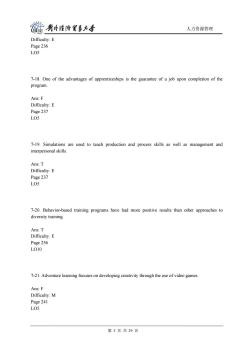
能男牛语降贸多大 人力资源管理 Difficulty:E Page 236 LO5 7-18.One of the advantages of apprenticeships is the guarantee of a job upon completion of the program. Ans:F Difficulty:E Page 237 L05 7-19.Simulations are used to teach production and process skills as well as management and interpersonal skills. Ans:T Difficulty:E Page 237 L05 7-20.Behavior-based training programs have had more positive results than other approaches to diversity training. Ans:T Difficulty:E Page 256 L010 7-21.Adventure learning focuses on developing creativity through the use of video games. Ans:F Difficulty:M Page 241 L05 第5页共29页
人力资源管理 Difficulty: E Page 236 LO5 7-18. One of the advantages of apprenticeships is the guarantee of a job upon completion of the program. Ans: F Difficulty: E Page 237 LO5 7-19. Simulations are used to teach production and process skills as well as management and interpersonal skills. Ans: T Difficulty: E Page 237 LO5 7-20. Behavior-based training programs have had more positive results than other approaches to diversity training. Ans: T Difficulty: E Page 256 LO10 7-21. Adventure learning focuses on developing creativity through the use of video games. Ans: F Difficulty: M Page 241 LO5 第 5 页 共 29 页

肖外径份氨多本是 人力资源管理 7-22.Evaluation designs without pretesting or comparison groups are most appropriate when the manager Is interested in identifying If a specific level of performance has been achieved. Ans:T Difficulty:M Page 246 LO8 7-23.Cost-benefit analysis is the process of determining the economic benefits of a training program using accounting methods. Ans:T Difficulty:E Page 247 LO8 7-24.One method for identifying the benefits of training is to check the technical,academic,and/or practitioner literature. Ans:T Difficulty:E Page 248 LO8 7-25.Cross-cultural preparation involves educating employees only who are being sent to a foreign country. Ans:T Difficulty:E Page 252 L09 第6页共29页
人力资源管理 7-22. Evaluation designs without pretesting or comparison groups are most appropriate when the manager Is interested in identifying If a specific level of performance has been achieved. Ans: T Difficulty: M Page 246 LO8 7-23. Cost-benefit analysis is the process of determining the economic benefits of a training program using accounting methods. Ans: T Difficulty: E Page 247 LO8 7-24. One method for identifying the benefits of training is to check the technical, academic, and/or practitioner literature. Ans: T Difficulty: E Page 248 LO8 7-25. Cross-cultural preparation involves educating employees only who are being sent to a foreign country. Ans: T Difficulty: E Page 252 LO9 第 6 页 共 29 页

莲喇母透降贸多大学 人力资源管理 Multiple Choice Questions 7-26.Which of the following is not true of high-leverage training? a.It benchmarks the company's training programs with other company's programs. b.It is linked to strategic business goals and objectives. c.It relies on an instructional design process. d.It uses the video-teleconferencing training techniques. Ans:d Difficulty:E Page 209 L01 7-27.When performing a needs assessment,which type of analysis should be performed last? a.Task analysis b.Organizational analysis c.Person analysis d.High-leverage analysis Ans:a Difficulty:M Page 211,Table 7.2 L03 7-28.Which of the following is not a feature of a learning organization? a.Needs analysis b.Information sharing c.Flexibility and risk taking d.Continuous learning Ans:a Difficulty:M Page 209,Table 7.1 L01 第7页共29页
人力资源管理 Multiple Choice Questions 7-26. Which of the following is not true of high-leverage training? a. It benchmarks the company’s training programs with other company’s programs. b. It is linked to strategic business goals and objectives. c. It relies on an instructional design process. d. It uses the video-teleconferencing training techniques. Ans: d Difficulty: E Page 209 LO1 7-27. When performing a needs assessment, which type of analysis should be performed last? a. Task analysis b. Organizational analysis c. Person analysis d. High-leverage analysis Ans: a Difficulty: M Page 211, Table 7.2 LO3 7-28. Which of the following is not a feature of a learning organization? a. Needs analysis b. Information sharing c. Flexibility and risk taking d. Continuous learning Ans: a Difficulty: M Page 209, Table 7.1 LO1 第 7 页 共 29 页

肖外径份氨多本是 人力资源管理 7-29.Which of the following is not a factor involved in the decision to choose training as a solution to a pressure point? a.Firm's strategic direction b.Support of managers and peers for training activities c.Training technique to be used d.Training resources available Ans:c Difficulty:M Page 212 L02 7-30.The first step in the instructional design process is a.creating a learning environment. b.conducting a needs analysis c.selecting training methods. d.ensuring employees'readiness for training. Ans:b Difficulty:M Page 211 L03 7-31.Which of the following was not identified as a training pressure point to consider during the needs assessment process? a.Performance problems b.New training techniques available c.Job redesign d.New legislation Ans:b Difficulty:M Page 211-212,Figure 7.1 LO3 7-32.Which of the following is not a training implication for an organization following a business 第8页共29页
人力资源管理 7-29. Which of the following is not a factor involved in the decision to choose training as a solution to a pressure point? a. Firm’s strategic direction b. Support of managers and peers for training activities c. Training technique to be used d. Training resources available Ans: c Difficulty: M Page 212 LO2 7-30. The first step in the instructional design process is a. creating a learning environment. b. conducting a needs analysis. c. selecting training methods. d. ensuring employees’ readiness for training. Ans: b Difficulty: M Page 211 LO3 7-31. Which of the following was not identified as a training pressure point to consider during the needs assessment process? a. Performance problems b. New training techniques available c. Job redesign d. New legislation Ans: b Difficulty: M Page 211-212, Figure 7.1 LO3 7-32. Which of the following is not a training implication for an organization following a business 第 8 页 共 29 页

渊外径舍贺多大景 人力资源管理 strategy of concentration? a.Cross training b.Team building c.Conflict negotiation skills d.Interpersonal skill training Ans:c Difficulty:H Page 213;Table 7.3 LOI 7-33.Which of the following is not a training implication for an organization following a business strategy of internal growth? a.Cross training b.Cultural training c.Conflict negotiation skills d.Technical competence in jobs Ans:a Difficulty:H Page 213;Table 7.3 LOI 7-34.Which of the following is not a training implication for an organization following a business strategy of external growth(acquisition)? a.Integrate training systems b.Team building c.Determine capabilities of employees in acquired firms d.On-the-job training Ans:d Difficulty:H Page 213;Table 7.3 L01 7-35.Which of the following is not a training implication for an organization following a business strategy of disinvestment? 第9页共29页
人力资源管理 strategy of concentration? a. Cross training b. Team building c. Conflict negotiation skills d. Interpersonal skill training Ans: c Difficulty: H Page 213; Table 7.3 LO1 7-33. Which of the following is not a training implication for an organization following a business strategy of internal growth? a. Cross training b. Cultural training c. Conflict negotiation skills d. Technical competence in jobs Ans: a Difficulty: H Page 213; Table 7.3 LO1 7-34. Which of the following is not a training implication for an organization following a business strategy of external growth (acquisition)? a. Integrate training systems b. Team building c. Determine capabilities of employees in acquired firms d. On-the-job training Ans: d Difficulty: H Page 213; Table 7.3 LO1 7-35. Which of the following is not a training implication for an organization following a business strategy of disinvestment? 第 9 页 共 29 页
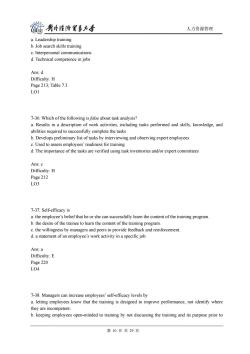
莲剥4将发多大号 人力资源管理 a.Leadership training b.Job search skills training c.Interpersonal communications d.Technical competence in jobs Ans:d Difficulty:H Page 213;Table 7.3 LOI 7-36.Which of the following is false about task analysis? a.Results in a description of work activities,including tasks performed and skills,knowledge,and abilities required to successfully complete the tasks b.Develops preliminary list of tasks by interviewing and observing expert employees c.Used to assess employees'readiness for training d.The importance of the tasks are verified using task inventories and/or expert committees Ans:c Difficulty:H Page 212 L03 7-37.Self-efficacy is a.the employee's belief that he or she can successfully learn the content of the training program. b.the desire of the trainee to learn the content of the training program. c.the willingness by managers and peers to provide feedback and reinforcement. d.a statement of an employee's work activity in a specific job. Ans:a Difficulty:E Page 220 L04 7-38.Managers can increase employees'self-efficacy levels by a.letting employees know that the training is designed to improve performance,not identify where they are incompetent. b.keeping employees open-minded to training by not discussing the training and its purpose prior to 第10页共29页
人力资源管理 a. Leadership training b. Job search skills training c. Interpersonal communications d. Technical competence in jobs Ans: d Difficulty: H Page 213; Table 7.3 LO1 7-36. Which of the following is false about task analysis? a. Results in a description of work activities, including tasks performed and skills, knowledge, and abilities required to successfully complete the tasks b. Develops preliminary list of tasks by interviewing and observing expert employees c. Used to assess employees’ readiness for training d. The importance of the tasks are verified using task inventories and/or expert committees Ans: c Difficulty: H Page 212 LO3 7-37. Self-efficacy is a. the employee’s belief that he or she can successfully learn the content of the training program. b. the desire of the trainee to learn the content of the training program. c. the willingness by managers and peers to provide feedback and reinforcement. d. a statement of an employee’s work activity in a specific job. Ans: a Difficulty: E Page 220 LO4 7-38. Managers can increase employees’self-efficacy levels by a. letting employees know that the training is designed to improve performance, not identify where they are incompetent. b. keeping employees open-minded to training by not discussing the training and its purpose prior to 第 10 页 共 29 页
按次数下载不扣除下载券;
注册用户24小时内重复下载只扣除一次;
顺序:VIP每日次数-->可用次数-->下载券;
- 对外经贸大学:《人力资源管理 Human Resource Management》课程教学资源(作业)Chapter 6 Appraising and Managing Performance.pdf
- 对外经贸大学:《人力资源管理 Human Resource Management》课程教学资源(作业)Chapter 5 Personnel Selection and Placement.pdf
- 对外经贸大学:《人力资源管理 Human Resource Management》课程教学资源(作业)Chapter 4 Human Resource Planning.pdf
- 对外经贸大学:《人力资源管理 Human Resource Management》课程教学资源(作业)Chapter 3 The Analysis and Design of Work.pdf
- 对外经贸大学:《人力资源管理 Human Resource Management》课程教学资源(作业)Chapter 2 Strategic Human Resource Management.pdf
- 对外经贸大学:《人力资源管理 Human Resource Management》课程教学资源(作业)Chapter 1 Human Resource Management:Gaining a Competitive Advantage.pdf
- 对外经济贸易大学:《营销学原理》课程教学资源(教学方案,英文).pdf
- 对外经济贸易大学:《营销学原理》课程教学资源(试题)1997-1998期末考试试卷二(英文,含答案).pdf
- 对外经济贸易大学:《营销学原理》课程教学资源(试题)2001-2002期末考试试卷一(英文,含答案).pdf
- 对外经济贸易大学:《营销学原理》课程教学大纲 Principles of Marketing(英文).pdf
- 对外经贸大学:《国际企业管理 International business management》课程教学资源(授课教案)第五篇 走出去战略 第十章 中国企业跨国经营战略.pdf
- 对外经贸大学:《国际企业管理 International business management》课程教学资源(授课教案)第四篇 跨国经营战略篇 第九章 跨国企业的资源寻求战略.pdf
- 对外经贸大学:《国际企业管理 International business management》课程教学资源(授课教案)第四篇 跨国经营战略篇 第八章 跨国企业营销战略.pdf
- 对外经贸大学:《国际企业管理 International business management》课程教学资源(授课教案)第四篇 跨国经营战略篇 第七章 获得全球竞争优势.pdf
- 对外经贸大学:《国际企业管理 International business management》课程教学资源(授课教案)第三篇 跨国进入战略 第六章 跨国进入方式.pdf
- 对外经贸大学:《国际企业管理 International business management》课程教学资源(授课教案)第三篇 跨国进入战略 第五章 跨国进入分析.pdf
- 对外经贸大学:《国际企业管理 International business management》课程教学资源(授课教案)第四章 基于发展中国家和地区的跨国经营理论.pdf
- 对外经贸大学:《国际企业管理 International business management》课程教学资源(授课教案)第二篇 跨国经营理论 第三章 基于外国直接投资(FDI)的跨国经营理论.pdf
- 对外经贸大学:《国际企业管理 International business management》课程教学资源(授课教案)第二篇 跨国经营理论 Part Two International Business Theories and Practices(第二章 基于贸易的跨国经营理论、第三章 基于外国直接投资(FDI)的跨国经营理论).pdf
- 对外经贸大学:《国际企业管理 International business management》课程教学资源(授课教案)第一篇 导论 第一章 跨国公司与跨国经营.pdf
- 对外经贸大学:《人力资源管理 Human Resource Management》课程教学资源(作业)Chapter 8 Pay Structure Decisions.pdf
- 对外经贸大学:《人力资源管理 Human Resource Management》课程教学资源(作业)Chapter 9 Recognizing Employee Contributions with Pay.pdf
- 对外经贸大学:《人力资源管理 Human Resource Management》课程教学资源(作业)Chapter 10 Managing Human Resources Globally.pdf
- 对外经贸大学:《人力资源管理 Human Resource Management》课程教学资源(授课教案)第一章 人力资源管理——赢得竞争优势.pdf
- 对外经贸大学:《人力资源管理 Human Resource Management》课程教学资源(授课教案)第二章 战略性人力资源管理 Strategic HR Management.pdf
- 对外经贸大学:《人力资源管理 Human Resource Management》课程教学资源(授课教案)第三章 工作分析与设计 The Analysis and Design of Work.pdf
- 对外经贸大学:《人力资源管理 Human Resource Management》课程教学资源(授课教案)第四章 人力资源规划.pdf
- 对外经贸大学:《人力资源管理 Human Resource Management》课程教学资源(授课教案)第五章 人员招聘与安置 Personnel Selection & Placement.pdf
- 对外经贸大学:《人力资源管理 Human Resource Management》课程教学资源(授课教案)第六章 绩效考核 Appraising and Managing Performance.pdf
- 对外经贸大学:《人力资源管理 Human Resource Management》课程教学资源(授课教案)第七章 员工培训与发展 Training and Developing Employees.pdf
- 对外经贸大学:《人力资源管理 Human Resource Management》课程教学资源(授课教案)第八章 薪酬方案 Establishing Pay Plans.pdf
- 对外经贸大学:《人力资源管理 Human Resource Management》课程教学资源(授课教案)第九章 绩效奖励与认可 Recognizing Employee Contributions with Pay.pdf
- 对外经贸大学:《人力资源管理 Human Resource Management》课程教学资源(授课教案)第十章 全球化的人力资源管理 Managing Global Human Resources.pdf
- 对外经济贸易大学:《管理信息系统》课程教学资源(作业)各章习题集.pdf
- 对外经济贸易大学:《管理信息系统》课程教学资源(案例)江铃国际管理信息系统案例分析.pdf
- 对外经济贸易大学:《管理信息系统》课程教学资源(试题)期末考试试卷(A卷).pdf
- 对外经济贸易大学:《管理信息系统》课程教学资源(试题)期末考试试卷(B卷).pdf
- 对外经济贸易大学:《管理信息系统》课程教学资源(复习要点).pdf
- 对外经济贸易大学:《管理信息系统》课程教学资源(实验指导)实验一 产品销售管理(Access数据库和表的使用).pdf
- 对外经济贸易大学:《管理信息系统》课程教学资源(实验指导)实验一 产品销售管理(查询).pdf
